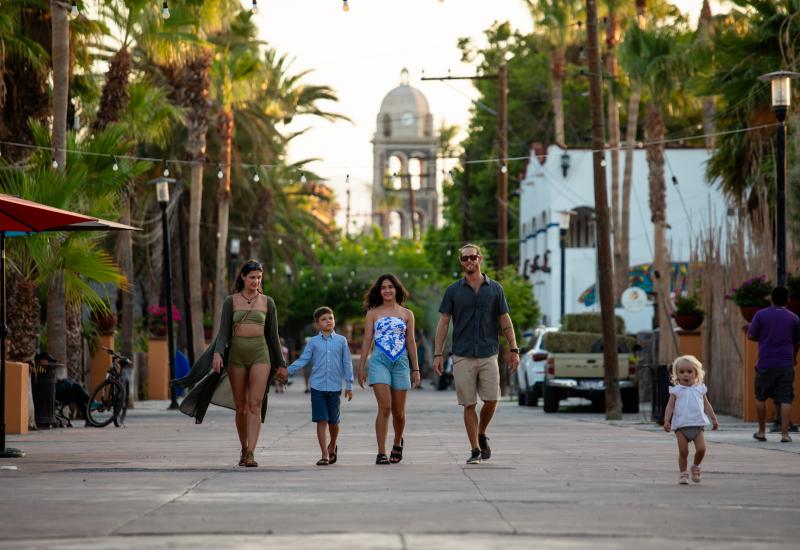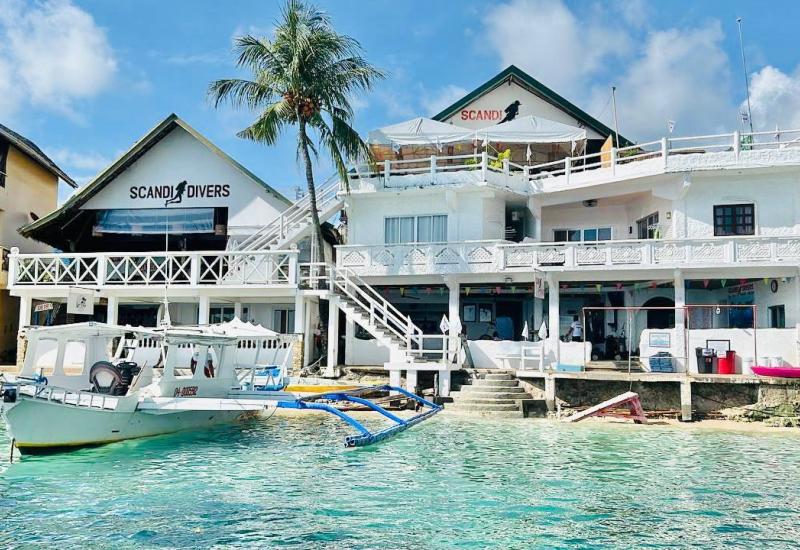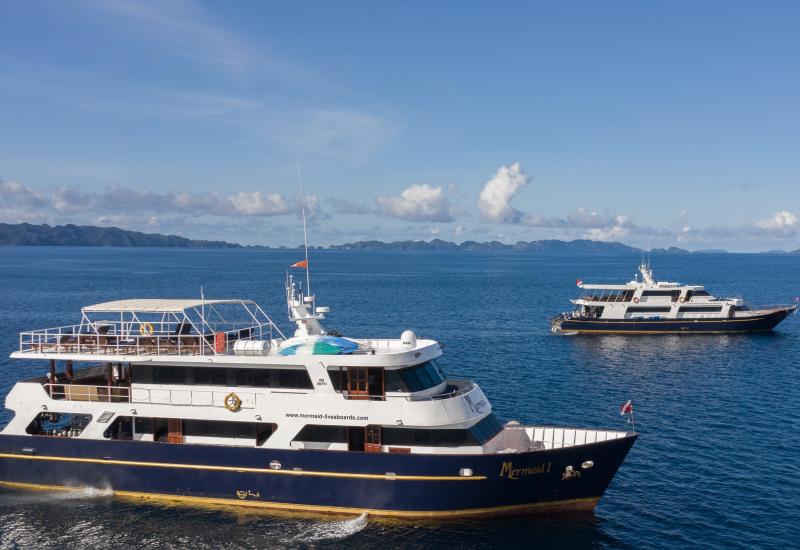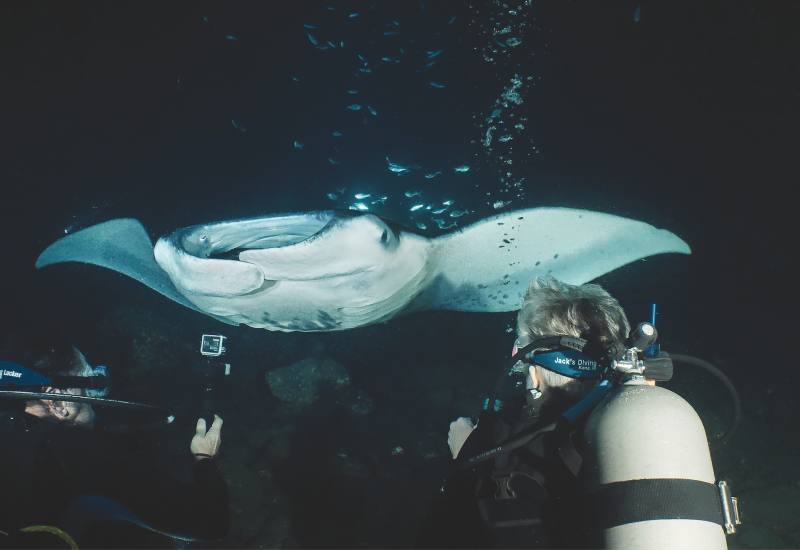Yap
 |
| Yapese children in traditional dress learn the heritage of dancing and chanting at an early age. |
January 2003
By J.C. Gamble
As the sun slips behind the mangrove forest on the western edge of Yap's Tomil Harbor, the mandarinfish awake. Bug-eyed with vibrant blue, green and orange striations, pairs of mandarinfish ply tips of finger coral and mate cheek-to-cheek in the late afternoon.
Frog-kicking at 15 feet with a dive light in one hand and Nikonos camera in the other, I strain to locate these colorful hummingbirds of the reef. My seemingly impossible objective, as several fellow photographers reminded me boatside, is a daunting ordeal--frame a coy mandarinfish in a 1:2 Nikonos extension tube.
The cooperation level increases as the sun fades, coaxing the pairs to leave their rooty enclaves for amorous encounters made illicit in the lights of videographers. The fish float about, spent from the workout, and retire to their jagged lairs for another 21-hour snooze. Just as it seems hopeless, a love-dazed male lights on the lens's framer and models for the shot. The paparazzi couldn't have ordered it better.
From the Mantas of Mi'il to the Magic Kingdom
||
|---|
|  |
|
| German Channel, gateway to a manta-filled morning.|
The dive boat picks its way through the thin passage of German Channel past banks lined with cherry crabs. When we see Rumung, northernmost of the four islands comprising Yap, Captain Henry Erecheilug flashes a toothy red smile of betelnut juice-stained molars and guns the throttle, ensuring we'll be the first boat buoyed up in Mi'il Channel. The reason for Henry's haste lies somewhere below: in the wash of the morning tide, giant mantas will be cruising among the coral cleaning stations.
Clad in black and white, the mantas ease through the haze of the channel's waters like regal ambassadors, fleshy kites gliding deliberately on tidal cue. It is estimated that more than a hundred of these graceful creatures congregate in Yap's waters with a majority making daily pilgrimages to have their gills and wings tended and picked free of parasites by the cleaner wrasse of coral stations. Others are drawn to the easy feeding in the channel's plankton-rich waters. They're acrobatic, often vaulting effortlessly in circular flight during the courtship rituals from December to April.
It is this consistent performance that has made the island of Yap synonymous with manta interactions. So common are the sightings that a majority of the mantas have been named and identified by the peculiar blotches that tattoo their underside. PADI has even sanctioned a Manta Awareness Specialty Course, which teaches responsible interaction with the famed devilfish.
 |
| The Hookup: Mandarinfish mate cheek-to-cheek with daily regularity in the finger corals of Tarang island. Typically, the male is the larger of the pair. |
South of Mi'il Channel, beginning along the western shoreline, are a cluster of wall sites flanking the island's southern tip. The diving here at sites like Cabbage Patch, Magic Kingdom, Gilman Wall, Yap Caverns and Lionfish Wall would alone put Yap on any diver's list of Micronesia stops. They have always, however, been overshadowed by the mantas' notoriety.
Yap's barrier reef is among the healthiest in the Pacific and these southern sites, which drop to 120 feet from the turquoise inner lagoon, are not to be missed. Hard plate corals, staghorn and cabbage corals, as well as invertebrates like crinoids and anemones, are populated by bumphead parrotfish, lionfish, five species of clownfish, pyramid butterflyfish and unlikely pelagics scouting the outer edge of intersecting currents. The visibility, consistently over 100 feet, makes it easy to spot passing sharks or dolphins drawn unexpectedly from the depths.
Divers are still unearthing new discoveries, both among the island's waters where an intact B-52 bomber remains hidden and also 100 miles northeast of Yap on Ulithi Atoll. The 553-foot U.S.S. Mississinewa was discovered on April 6, 2001, lying upside down on the lagoon floor at 120 feet where she'd been since a Japanese kaiten submarine attack on Nov. 20, 1944.
Something Mnuw in Tomil
||
|---|
|  |
|
| More than just mantas and mandarinfish: Yap's walls and reefs alone, like Gilman Wall seen here, are worth the trip.|
"They speak a different type of English in Georgia than they do in Texas?" questions Bill Acker, aka "Mr. Manta," as I greet him on the Crow's Nest of the pirate ship Mnuw.
The Crow's Nest is not only the ship's tower but also a top deck sunset bar with the best view of Tomil Harbor in Yap. Acker is a little perturbed that I skipped out on a long night of drinking Budweiser (Yapese drink more Bud than any other country per capita), but we reconcile.
"Oh, hanging out with Peace Corps girls?" says Acker, a native Texan with a distinctly un-Yapese gray Fu Manchu mustache. "Guess that's OK."
Acker is well-acquainted with the beneficent volunteer brigade John F. Kennedy founded in 1964. He was stationed during his '76 to '78 tenure in the corps on Ulithi Atoll and Yap, and was so moved by the island "its climate, water and people" that he soon returned in 1980. By 1986, he had opened a dive shop.
 |
| A trio of mantas soar above one of several cleaning stations in Mi'il Channel. |
And while Acker is undeniably one of the best-known proponents of Yap and its culture, he is by no means the first. Captain David Dean O'Keefe, an Irishman for whom the small island of Tarang is named, was also lured by Yap's spell at the end of the 19th century. Shipwrecked on the southern reef, O'Keefe opted to make Yap his permanent residence, exporting copra while helping the Yapese transport stone money. A bar across the street from Manta Ray Bay bears his name and celebrates this one-time island legend with framed movie posters of the Burt Lancaster's O'Keefe from the '50s.
"It was a terrible film," says an anonymous Peace Corps volunteer over cans of Bud at O'Keefe's Kanteen. "But there's talk of a remake."
Much like O'Keefe's ship, which grounded on Yap's outer reef, Acker's Phinisi-style South Seas schooner the Mnuw, named to honor a rare Micronesian sea hawk, towers over the harbor like some misplaced galleon. The 12-day oceanic haul he made to move the ship from Indonesia was not unlike those made for centuries by Yapese islanders to Palau to mine the calcite-rich limestone of the rock islands into giant wheels of stone money. Men transported these massive discs of limestone by shouldering logs inserted through the money's center and then moving them hundreds of miles in canoes and outriggers shaped from breadfruit trees.
Today, there are more than 13,000 of these coins in open-air village banks throughout the island; there's even a coral-coated one on the reef of Mi'il Channel. It was placed there for a photo shoot as a foreground subject for a wide-angle shot of circling mantas. It is likely that more of these enormous coins lie scattered on the seafloor between Yap and Palau as a result of money-laden boats capsizing at sea.
On Yap, centuries-old traditions are still very much in evidence. Outside the capital city Colonia, women go topless and wear lavalavas and skirts woven from banana, betelnut and fern leaves. From an early age, Yapese children learn the standards of traditional dress and the highly artistic dances and chants.
Small, thriving villages like Kaday demonstrate the resilience of an island heritage that has withstood many occupations--Spain, Germany and Japan before the U.S. assumed post-war administration of the Federated States of Micronesia.
The Good Life
The flight out of Yap departs just after midnight, so to pass the time prior to departure, Acker and I find ourselves again in the Crow's Nest, the few lights of civilization spread out on the harbor's inner lagoon.
Across the bay, near the dock cleats of Tarang, the mandarinfish are deep in slumber, exhausted from another dusk's lovefest on the reef. I have to admit I'm envious of the carefree mandarinfish of Yap's finger corals. They seem well-acquainted with the good life.
 |
Dive In: Yap
LOCATION In the Western Carolines of the Western Pacific between Guam and Palau.
GETTING THERE Continental Air Micronesia (www.continental.com) connects out of Houston and Newark with stopovers in either Los Angeles or Honolulu. Flights also connect to Yap via Manila for European travelers. Count on an overnight or extended layover in Guam prior to an early morning Sunday, Wednesday or Thursday flight to Yap when traveling from the states.
DOCUMENTS A passport and a return ticket are necessary for entrance into Yap.
CLIMATE Temperatures average 85F year-round with frequent high humidity.
WATER TEMPERATURES Temperatures vary from 80 to 86F but a 1mm wetsuit is advisable. Water visibility in the channels hovers around 40 feet, but improves dramatically on the fringing slopes.
MONEY The U.S. dollar is legal tender on Yap. Credit cards are accepted at the hotels and restaurants on the island. Yap has two banks -- Bank of the FSM and the Bank of Hawaii.
ELECTRICITY 110 volts, 60 cycles like the U.S. and Canada.
FOR MORE INFORMATION Contact the Yap Visitors Bureau at (011) 691-350-2298 or visit them online at www.visityap.org or e-mail them at [email protected].
Yapese children in traditional dress learn the heritage of dancing and chanting at an early age.
January 2003
By J.C. Gamble
As the sun slips behind the mangrove forest on the western edge of Yap's Tomil Harbor, the mandarinfish awake. Bug-eyed with vibrant blue, green and orange striations, pairs of mandarinfish ply tips of finger coral and mate cheek-to-cheek in the late afternoon.
Frog-kicking at 15 feet with a dive light in one hand and Nikonos camera in the other, I strain to locate these colorful hummingbirds of the reef. My seemingly impossible objective, as several fellow photographers reminded me boatside, is a daunting ordeal--frame a coy mandarinfish in a 1:2 Nikonos extension tube.
The cooperation level increases as the sun fades, coaxing the pairs to leave their rooty enclaves for amorous encounters made illicit in the lights of videographers. The fish float about, spent from the workout, and retire to their jagged lairs for another 21-hour snooze. Just as it seems hopeless, a love-dazed male lights on the lens's framer and models for the shot. The paparazzi couldn't have ordered it better.
From the Mantas of Mi'il to the Magic Kingdom
German Channel, gateway to a manta-filled morning. The dive boat picks its way through the thin passage of German Channel past banks lined with cherry crabs. When we see Rumung, northernmost of the four islands comprising Yap, Captain Henry Erecheilug flashes a toothy red smile of betelnut juice-stained molars and guns the throttle, ensuring we'll be the first boat buoyed up in Mi'il Channel. The reason for Henry's haste lies somewhere below: in the wash of the morning tide, giant mantas will be cruising among the coral cleaning stations.
Clad in black and white, the mantas ease through the haze of the channel's waters like regal ambassadors, fleshy kites gliding deliberately on tidal cue. It is estimated that more than a hundred of these graceful creatures congregate in Yap's waters with a majority making daily pilgrimages to have their gills and wings tended and picked free of parasites by the cleaner wrasse of coral stations. Others are drawn to the easy feeding in the channel's plankton-rich waters. They're acrobatic, often vaulting effortlessly in circular flight during the courtship rituals from December to April.
It is this consistent performance that has made the island of Yap synonymous with manta interactions. So common are the sightings that a majority of the mantas have been named and identified by the peculiar blotches that tattoo their underside. PADI has even sanctioned a Manta Awareness Specialty Course, which teaches responsible interaction with the famed devilfish.
The Hookup: Mandarinfish mate cheek-to-cheek with daily regularity in the finger corals of Tarang island. Typically, the male is the larger of the pair.
South of Mi'il Channel, beginning along the western shoreline, are a cluster of wall sites flanking the island's southern tip. The diving here at sites like Cabbage Patch, Magic Kingdom, Gilman Wall, Yap Caverns and Lionfish Wall would alone put Yap on any diver's list of Micronesia stops. They have always, however, been overshadowed by the mantas' notoriety.
Yap's barrier reef is among the healthiest in the Pacific and these southern sites, which drop to 120 feet from the turquoise inner lagoon, are not to be missed. Hard plate corals, staghorn and cabbage corals, as well as invertebrates like crinoids and anemones, are populated by bumphead parrotfish, lionfish, five species of clownfish, pyramid butterflyfish and unlikely pelagics scouting the outer edge of intersecting currents. The visibility, consistently over 100 feet, makes it easy to spot passing sharks or dolphins drawn unexpectedly from the depths.
Divers are still unearthing new discoveries, both among the island's waters where an intact B-52 bomber remains hidden and also 100 miles northeast of Yap on Ulithi Atoll. The 553-foot U.S.S. Mississinewa was discovered on April 6, 2001, lying upside down on the lagoon floor at 120 feet where she'd been since a Japanese kaiten submarine attack on Nov. 20, 1944.
Something Mnuw in Tomil
More than just mantas and mandarinfish: Yap's walls and reefs alone, like Gilman Wall seen here, are worth the trip. "They speak a different type of English in Georgia than they do in Texas?" questions Bill Acker, aka "Mr. Manta," as I greet him on the Crow's Nest of the pirate ship Mnuw.
The Crow's Nest is not only the ship's tower but also a top deck sunset bar with the best view of Tomil Harbor in Yap. Acker is a little perturbed that I skipped out on a long night of drinking Budweiser (Yapese drink more Bud than any other country per capita), but we reconcile.
"Oh, hanging out with Peace Corps girls?" says Acker, a native Texan with a distinctly un-Yapese gray Fu Manchu mustache. "Guess that's OK."
Acker is well-acquainted with the beneficent volunteer brigade John F. Kennedy founded in 1964. He was stationed during his '76 to '78 tenure in the corps on Ulithi Atoll and Yap, and was so moved by the island "its climate, water and people" that he soon returned in 1980. By 1986, he had opened a dive shop.
 A trio of mantas soar above one of several cleaning stations in Mi'il Channel.
A trio of mantas soar above one of several cleaning stations in Mi'il Channel.
And while Acker is undeniably one of the best-known proponents of Yap and its culture, he is by no means the first. Captain David Dean O'Keefe, an Irishman for whom the small island of Tarang is named, was also lured by Yap's spell at the end of the 19th century. Shipwrecked on the southern reef, O'Keefe opted to make Yap his permanent residence, exporting copra while helping the Yapese transport stone money. A bar across the street from Manta Ray Bay bears his name and celebrates this one-time island legend with framed movie posters of the Burt Lancaster's O'Keefe from the '50s.
"It was a terrible film," says an anonymous Peace Corps volunteer over cans of Bud at O'Keefe's Kanteen. "But there's talk of a remake."
Much like O'Keefe's ship, which grounded on Yap's outer reef, Acker's Phinisi-style South Seas schooner the Mnuw, named to honor a rare Micronesian sea hawk, towers over the harbor like some misplaced galleon. The 12-day oceanic haul he made to move the ship from Indonesia was not unlike those made for centuries by Yapese islanders to Palau to mine the calcite-rich limestone of the rock islands into giant wheels of stone money. Men transported these massive discs of limestone by shouldering logs inserted through the money's center and then moving them hundreds of miles in canoes and outriggers shaped from breadfruit trees.
Today, there are more than 13,000 of these coins in open-air village banks throughout the island; there's even a coral-coated one on the reef of Mi'il Channel. It was placed there for a photo shoot as a foreground subject for a wide-angle shot of circling mantas. It is likely that more of these enormous coins lie scattered on the seafloor between Yap and Palau as a result of money-laden boats capsizing at sea.
On Yap, centuries-old traditions are still very much in evidence. Outside the capital city Colonia, women go topless and wear lavalavas and skirts woven from banana, betelnut and fern leaves. From an early age, Yapese children learn the standards of traditional dress and the highly artistic dances and chants.
Small, thriving villages like Kaday demonstrate the resilience of an island heritage that has withstood many occupations--Spain, Germany and Japan before the U.S. assumed post-war administration of the Federated States of Micronesia.
The Good Life
The flight out of Yap departs just after midnight, so to pass the time prior to departure, Acker and I find ourselves again in the Crow's Nest, the few lights of civilization spread out on the harbor's inner lagoon.
Across the bay, near the dock cleats of Tarang, the mandarinfish are deep in slumber, exhausted from another dusk's lovefest on the reef. I have to admit I'm envious of the carefree mandarinfish of Yap's finger corals. They seem well-acquainted with the good life.
Dive In: Yap
LOCATION In the Western Carolines of the Western Pacific between Guam and Palau.
GETTING THERE Continental Air Micronesia (www.continental.com) connects out of Houston and Newark with stopovers in either Los Angeles or Honolulu. Flights also connect to Yap via Manila for European travelers. Count on an overnight or extended layover in Guam prior to an early morning Sunday, Wednesday or Thursday flight to Yap when traveling from the states.
DOCUMENTS A passport and a return ticket are necessary for entrance into Yap.
CLIMATE Temperatures average 85F year-round with frequent high humidity.
WATER TEMPERATURES Temperatures vary from 80 to 86F but a 1mm wetsuit is advisable. Water visibility in the channels hovers around 40 feet, but improves dramatically on the fringing slopes.
MONEY The U.S. dollar is legal tender on Yap. Credit cards are accepted at the hotels and restaurants on the island. Yap has two banks -- Bank of the FSM and the Bank of Hawaii.
ELECTRICITY 110 volts, 60 cycles like the U.S. and Canada.
FOR MORE INFORMATION Contact the Yap Visitors Bureau at (011) 691-350-2298 or visit them online at www.visityap.org or e-mail them at [email protected].










